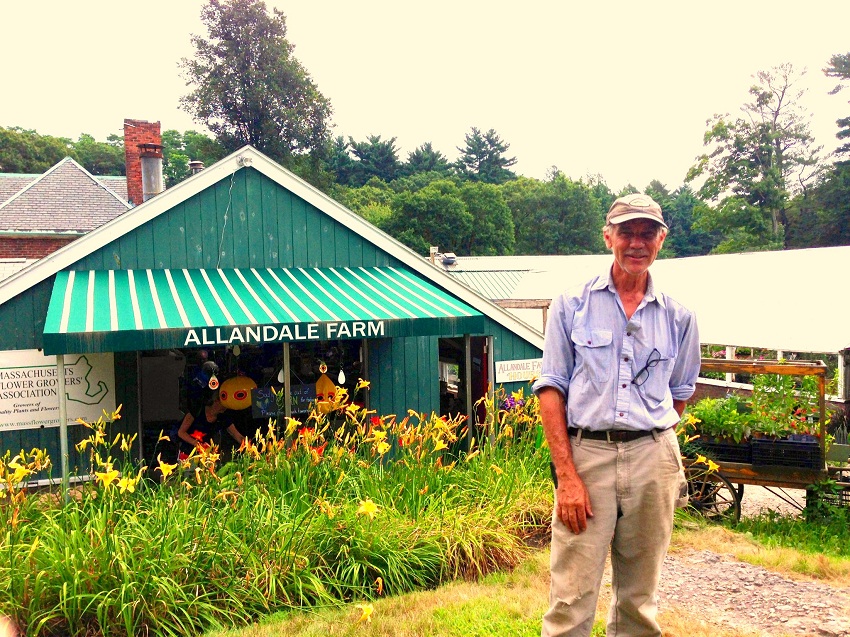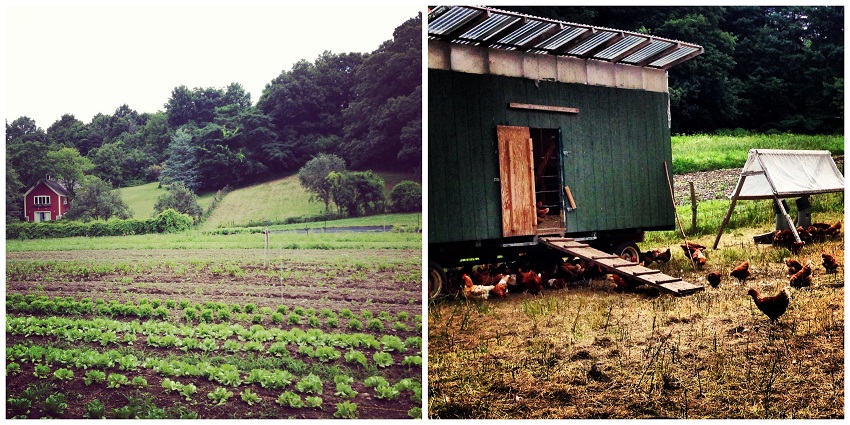Supply Chain: Allandale Farm’s Urban Oasis
Welcome to Supply Chain, where we go behind the plate to get a feel for the day-to-day of Boston’s most relied-upon restaurant purveyors.
John Lee doesn’t mind a little rain. When a few fat drops start dotting the stretch of dirt road and the ink on my notes begins to run, I start digging around in my bag for my umbrella, anticipating a deluge. He waves it off. “It’ll pass quickly,” he says, squinting up from under his worn baseball hat at the clouds stretching over the rolling green hills. Away goes the umbrella, and we continue along the path, cutting through a field crisscrossed with neat rows of flowers.
No, we are not frolicking about somewhere deep in the New England wilderness, although it certainly feels like it—instead, we happen to be standing on 30 acres smack in the middle of the Boston-Brookline border. As the general manager of Allandale Farm, Lee, who is tall and lanky with a bristly white mustache, is the steward of this 250-year old land.
Now known for wearing two hats—one, as a supplier of produce to small local restaurants and grocery stores, the other as a beloved neighborhood farm stand (and host of the annual tomato festival on August 11)—Allandale has only been working with restaurants for about ten years. Lee’s requirement for a solid partnership is simple: the food has to be good.
“That’s really it!” he says, shrugging. “Really. If I’m selling you produce, all I want is to know you’ll do a good job with it. All of the chefs we work with are great at what they do.”
It’s true, talent is something their client list is in no way lacking, with Lineage in Brookline, Sycamore in Newton, Vee Vee in Jamaica Plain, and Mei Mei Street Kitchen making appearances. Each week, Lee and his staff send out everything from squash blossoms to daikon radishes to a fluctuating list of around 16 restaurant kitchens, along with a few Whole Foods locations.
“This is not big business. I mean, it looks big, but it’s not,” he says, waving his arm at the fields. There’s another 30 acres in Groton to consider as well, where the more time-intensive crops like onions, pumpkins, and potatoes are grown. “We’ve gone from being a beer capital to a food capital in this city, and it’s a great market. Our business has grown measurably every year, for at least the last ten years…people like to eat here, thank goodness.”
While our love of eating may keep him in business, our charmed fascination with all things rustic and farm-to-fork has heralded along some strange side effects—some admirable, some tiresome—for him and his crew. It’s something that Lee likens to the “first wave” of the idealization of farming lifestyles that he first saw in the 1960s.
“It was an unscientific, and unrealistic, attitude towards agriculture and small-scale farming. Suffice it to say, it didn’t last all that long,” he says. We pass a group of kids all seated in a circle in the middle of a grove of trees, pails of fresh eggs sitting nearby. “This generation of people who are interested in farming are much more business-minded. That’s not to say they’re cutthroat, but they’ve got a much better understanding of how to get into business and stay there.”
The kids all yell something in unison, as one of the farm employees reads a story out loud. A few feet away, 350 chickens strut around in the grass.
“And farmers have become the super chic ones,” he admits. I ask him if he thinks of himself as super chic, and he giggles a little and says no, definitely not. “I keep my head down. But, I want my head grower to feel super chic if he’s into that.”
Chic or not, Lee and his staff are constantly exploring the possibilities within the land. They’ve begun dabbling in shitakes and maitakes, and he mentions that in the past they’ve considered playing around with hops or wine grapes.
“I try to find things that fit into the big picture,” he says, as we end our jaunt back at the farm stand. “Because so often I tend to look at the land and say, I wish I could find something to do with that hill over there besides growing trees on it!”
History is something that is intimately felt at Allandale—in the 20s and 30s, he explains, said hill was covered in extremely productive orchards, not woods, and not vegetable patches as it is now. In the beginning of the 20th century for that matter, there was hardly a tree to be found in Massachusetts, and the land was left open to better herd sheep and cows.
Lee tells me that tucked away in the wilder parts of the property, remnants of stonewalls can still be found, crumbling away. There’s a moment’s pause while we try to imagine reversing our surroundings in time. He seems happy to be a part of the land’s timeline at all.
“I do this because I love doing it,” he says. “I love this farm and I’ve been at it for so long. It was pretty much nothing when I started, and now it’s become a pretty good business.”
“This would have been the country, you know,” he adds as a final thought. “Successful businessmen in Boston would have had a country house here, and it would have been a half-day ride in a carriage. Now, you just take the bus.”




